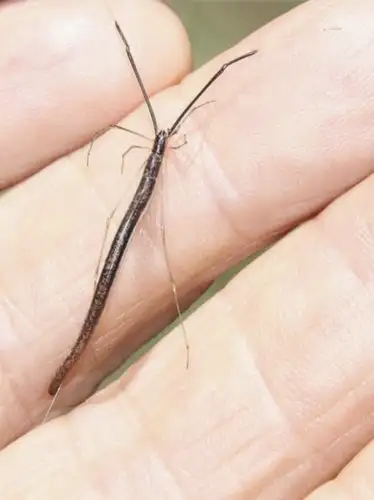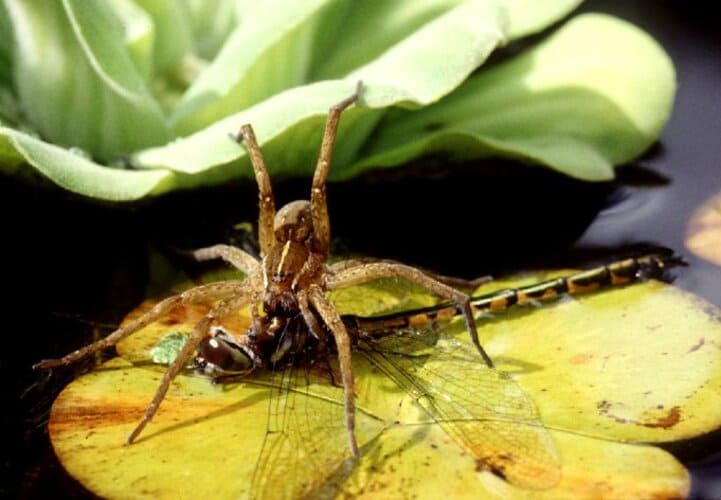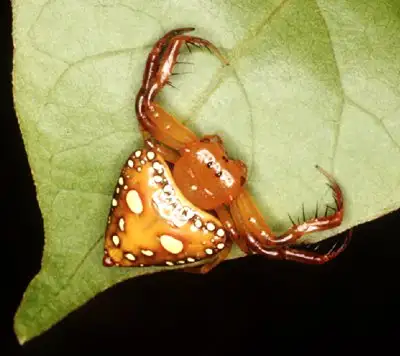The head is perpendicular to the body axis and has two simple eyes located between the compound eyes. The antennae are bristle-like and have three segments. The pronotum extends backward to the upper abdomen, often covering most of the body, and has various horn-like protrusions, which is a distinctive feature of this family. The scutellum is hidden or visible, the forewings are transparent or translucent, the tibia of the foot is ridged, the tarsus has three segments, and the base of the hind foot is horizontal.
Details
Membracidae are members of the family Membracidae, in the order Homoptera, class Insecta, and are often called "tree lice" or There are more than 3,000 known species of lice worldwide. Cicada. They are known for their unique appearance and rich species diversity, especially the unique shape of the protrusions on their backs, which often resemble plant thorns or bark, making them easy to identify Blending into the environment, becoming a master of camouflage.
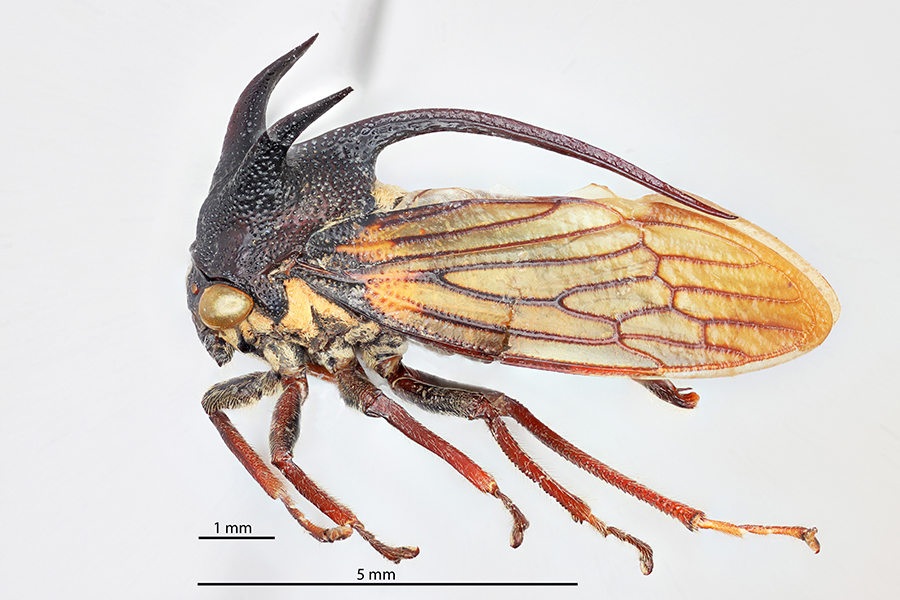
Basic characteristics of treehoppers
Body size: The stinging insects are small, generally about 5-12 mm long, with a relatively simple shape and colors ranging from green, brown, and black. From yellow to yellow, some species even have bright patterns or spots.
Back protrusions (shield protrusions): The most notable feature of stinging insects is the shield-like protrusions on their backs. These protrusions have various shapes. Some species have protrusions that look like branches, thorns, leaves, or even other insects. This morphological camouflage allows stinging insects to effectively hide from predators, such as birds and other predatory insects.
Feeding method: Stinging insects are sucking insects, mainly feeding on the sap of trees and plants. They use small The long mouthparts pierce the plant's epidermis and suck the plant's sap.
Classification of Treehoppers
There are multiple subfamilies and genera , here are some of the main classifications of the treehopper family:
Centrotinae: These treehoppers have protuberances on their backs that often resemble those on leaves or tree trunks. Used for camouflage.
Membracinae: This group of stinging insects has flat, mostly rounded protrusions. Darker colors are used to simulate bark or moss.
Heliconinae: Brightly colored and finely patterned, with complex and varied dorsal protuberances that often mimic flowers or insects in the surrounding environment.
Treehopper's behavior and ecology
Camouflage and defense mechanism: The dorsal protuberances of treehoppers are not only used for >camouflage and can also scare off predators, for example, they sometimes mimic insects such as ants and bees to scare off potential threats.
Gathering behavior: Some species have obvious gregarious behavior, and they usually gather on branches or leaves to improve their defense capabilities through collective action.
Mating and reproduction: Stinging insects mate and court by emitting vibration signals. Female insects lay eggs on plants. After the eggs hatch, the larvae usually continue to stay near the mother and be cared for by the mother for a period of time. This is a relatively rare parental care behavior in the insect world.
Distribution and habitat

Widely distributed throughout the world, mainly living in tropical and subtropical regions, such as tropical rainforests in Central and South America, Africa and Asia. They mostly live in trees and bushes, and especially like humid environments. In these areas, treehoppers can be very prosperous, with large numbers and high diversity.
Ecological Roles of Treehoppers
Pollination Role: Although treehoppers are pests that suck plant sap, they may also help plants pollinate in some cases, especially when they migrate or move, where they may carry pollen.
Honeydew Production: Treehoppers secrete honeydew, a sugary liquid that insects such as ants follow to get the honeydew. Ants also "protect" the stinging insects from predators, forming a mutually beneficial symbiotic relationship.
Pests: Treehoppers can sometimes have a negative impact on agriculture, especially when they suck sap from trees and crops in large quantities, which can cause plant growth to slow or even die. In fruit trees and some cash crops, Treehoppers are considered pests and need to be controlled.
Consumption of Treehoppers
It is not a traditional edible insect, and due to its small size and low nutritional value, it is rarely found in the human food chain. However, in some areas where insect consumption culture is prevalent, such as Southeast Asia, there may be a habit of eating insects, but Treehoppers are not usually widely used as food.
Conservation status of treehoppers
Treehoppers are generally stable in number, and due to their large number of species, they are not listed as endangered. However, their habitats, such as rainforests, are threatened by deforestation and climate change, so the living environment of some treehoppers may be affected to a certain extent. Maintaining biodiversity and protecting forest ecosystems are also crucial for the survival of small creatures such as treehoppers.
Summary
treehoppers are a family of strange-looking and highly diverse insects. Known for their unique dorsal protuberances and highly developed camouflage skills, they have adapted to a variety of tropical and subtropical environments. Although they are sometimes considered pests in agriculture, they also contribute to the balance of the ecosystem, especially in their symbiotic relationship with ants. The existence of treehoppers further demonstrates the wonder and diversity of the natural world.
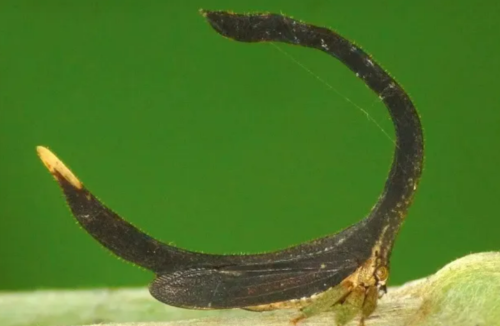
Membracidae is a species of thorn insects belonging to the order Homoptera, often calledtree cicada or horn louse strong>. Treehoppers are known for the distinctive horn-like projections on their backs, which help them camouflage themselves on branches and plants. Treehoppers are very diverse, with more than 3,000 species known worldwide. Distributed in different geographical areas. Here are some common treehopper species and their characteristics:
1. Bullhornhopper (Umbonia crassicornis)
Distribution: Mainly distributed in Central America and South America, and sometimes can be seen in tropical and subtropical areas of North America to.
Appearance characteristics: The horn cicada is named for the horn-like protrusions on its back. There is a huge, backward-curved protrusion on its back. The thorn-like structures, usually green or yellow, can blend in with the spines of the plant, acting as camouflage.
Ecological characteristics: Horned cicadas mainly live in trees and bushes, sucking plant sap. They have a very strong camouflage ability and usually blend in with the environment. as one.
2. Triangular Treehopper (Membracis mexicana)
Distribution: Distributed in Central and South America, especially in tropical rainforests.
Appearance characteristics: The dorsal protrusion of this type of treehopper is triangular, relatively flat and wide, usually brown or green, very similar to tree bark.
Ecological characteristics: Triangular treehoppers often appear in groups on trees, and the protrusions on their backs can effectively protect them from attacks by natural enemies.
3. Leaf-shaped Treehopper (Cyrtolobus tuberosus)
< p>Location: Mainly found in North America, especially in forests and scrubland in the eastern United States.
Appearance: The dorsal protuberances of leafhoppers resemble leaves and are similar in color to the surrounding leaves, usually green or brown. The structure of their dorsal protuberances makes them difficult for predators to detect.
Ecological characteristics: They usually live alone on branches or leaves and feed on plant sap.
4. Armored Treehopper (Thelia bimaculata)
Location: Distributed in eastern North America, preferring to live near temperate forests and wetlands.
Appearance: The back protrusions of the armored treehopper are like a piece of armor, broad and solid, usually dark brown or gray. The color and shape of the protrusions make them look like nodules on branches.
Ecological characteristics: They suck sap from trees, especially oaks, and often form clusters on the bark.
5. Horned Treehopper (Bocydium globulare)
Distribution: Mainly distributed in tropical rainforests in South America, especially in forests in Brazil, Peru and other places.
Appearance: This is one of the most unique treehoppers. The protrusions on its back resemble "horns" and there are small spherical structures on the top. The overall look is like an insect carrying a pair of horns and small balls, which is very strange.
Ecological characteristics: This treehopper moves on leaves. The horn-like protrusions on its back make it look like a seed or fruit of a plant, achieving a camouflage effect.
6. Shielded Treehopper (Stictocephala bisonia)
Distribution: Mainly distributed in North America and South America, commonly found in grasslands, orchards and woodlands.
Appearance: Shielded treehoppers have a shield-like protrusion on their backs, which is usually green or brown. The protrusion is relatively flat and looks like a plant leaf.
Ecological characteristics: They mainly parasitize on fruit trees and shrubs, sucking the sap of plants, and are sometimes considered pests of crops.
7. Transparent Treehopper (Smilia camelus)
Distribution: Distributed in North America, especially in the forests of the United States and Canada.
Appearance: The protrusions of the transparent treehopper are relatively slender, shaped like the twigs of plants, and the color is usually transparent or translucent, which further enhances its camouflage effect.
Ecological characteristics: This treehopper clings to branches and is difficult to be found when it is still. It mainly feeds on tree sap.
8. Enchenopa binotata
Distribution: Distributed in eastern North America, especially in humid forests and riverbanks.
Appearance: The protrusions on the back of the long-horned cicada are like slender horns, usually green or brown in color, imitating the shape of tree branches.
Ecological characteristics: They often appear on a variety of plants, especially vines and oaks, sucking plant sap and using the protrusions on the back for camouflage.
Summary
There are many species in the tree cicada family, and each tree cicada has its own unique appearance and ecological characteristics. They usually use the protrusions on their backs for camouflage to avoid predators, and have adapted to different habitats, from tropical rainforests to temperate forests, from leaves to bushes, and tree cicadas everywhere have their own survival strategies. Through this special camouflage skill, tree cicadas show the diversity and wonderful evolutionary path in nature.
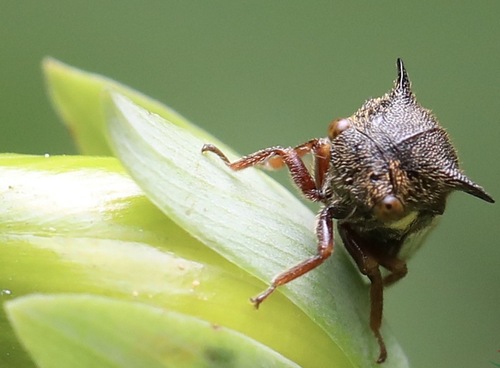
Is it a beneficial insect or a pest
Treehoppers (Membracidae) feed primarily on plant sap, so they may be considered pests in some contexts, especially in agricultural settings, to cash crops and fruit trees.
Treehoppers as pests:
Sucking plant sap: Treehoppers use their piercing-sucking mouthparts to penetrate plant stems and leaves and suck sap. This can weaken plant health, causing slower growth, leaf wilting, and even plant death, especially when treehopper populations are dense.
Transmission of plant diseases: Some treehoppers may become transmission vectors of plant diseases when sucking plant sap, carrying and spreading bacteria or viruses, and thus causing plant diseases. This needs special attention in agricultural production.
Treehoppers as beneficial insects:
Although treehoppers are often regarded as pests, they also play certain ecological roles in natural ecosystems:
Mutual symbiosis with ants: The honeydew secreted by treehoppers attracts ants, and ants protect treehoppers from natural enemies. This relationship helps maintain the balance of the ecosystem.
As a link in the food chain: Treehoppers are an important food source for predators such as some birds, spiders, and parasitic wasps. Their presence in nature helps maintain biodiversity.
Conclusion
In natural ecosystems, treehoppers do not pose a serious threat to the environment, but in agriculture and horticulture, when treehopper populations are excessive, they may cause damage to crops and are therefore considered pests. Appropriate management measures for different species and environments can reduce the negative impact of treehoppers on agriculture.
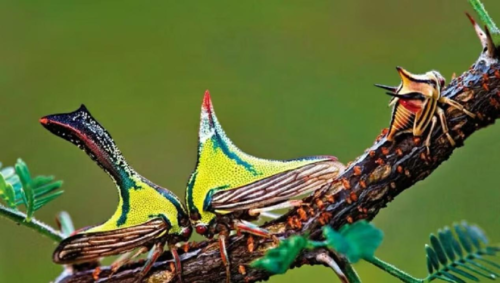
Treehoppers have many natural enemies in nature, which can prey on or parasitize them, helping to control their population and maintain ecological balance. The following are the main natural enemies of treehoppers:
1. Birds
Predator Types: Many small insect-eating birds, such as sparrows, swallows, and tits, will prey on treehoppers and other small insects.
Predation Method: These birds will directly catch treehoppers, especially when they are active or migrating, and they are more likely to be exposed.
2. Spiders
Predator Types: Spiders such as garden spiders, jumping spiders, and wolf spiders may prey on tree cicadas.
Predation Method: Spiders capture tree cicadas by weaving webs or ambushing them directly. Tree cicadas may be accidentally caught in spider webs when they are active on trees or shrubs.
3. Parasitic wasps
Parasitic wasp types: Small Parasitic wasps (such as some species of Chrysopidae and Mylidae) often parasitize on the eggs or larvae of tree cicadas.
Parasitic method: Parasitic wasps lay eggs in the eggs of tree cicadas, and after hatching, the young wasps will slowly eat the eggs or larvae of tree cicadas from the inside, eventually leading to the death of the tree cicadas.
4. Praying Mantis
Predator Type: Praying Mantis is one of the top predators in the insect world. They prey on small insects such as tree cicadas.
Predation Method: Praying Mantises use their powerful front legs to catch tree cicadas and quickly bite off their heads and bodies for consumption.
5. Frogs and Lizards
Predator Types: Small amphibians and reptiles such as frogs and lizards prey on treehoppers near trees and bushes where they live.
Predation Method: These animals use their tongues or mouths to quickly catch treehoppers moving in the trees.
Predator Types: Bats, especially insectivorous species, will catch treehoppers in flight at night.
Predation Method: Bats use echolocation to detect treehoppers and prey on them in flight.
Predator Species: Although treehoppers have a symbiotic relationship with ants, where ants protect treehoppers for honeydew, certain ant species (such as red fire ants) may attack and prey on treehoppers.
Predation Method: Ants will attack individual treehoppers or their eggs, eating their bodies.
8. Predatory Insects
Predator Types: Some predatory insects, such as ladybugs and ground beetles, will also prey on treehopper larvae or adults.
Predation Method: These insects prey on treehoppers through rapid capture movements, especially when they are young or exposed.
9. Parasitic fungi
Parasitic type: Some insect parasitic fungi, such as Cordyceps, infect tree cicadas and spread fungal spores to parasitize tree cicadas.
Parasitic method: Parasitic fungi infect the tree cicada's shell, reproduce in its body, and eventually cause the tree cicada to die. Infected tree cicadas often show abnormal behavior, which affects their normal activities.
Summary
The natural enemies of treehoppers are widely distributed in multiple ecological niches in nature, including birds, spiders, mantises, parasitic wasps and predatory insects. These natural enemies effectively control the population of treehoppers and maintain the balance of the ecosystem through predation, parasitism or infection. In agriculture or orchards, using natural enemies of treehoppers for biological control is a feasible strategy that helps reduce the use of chemical pesticides.
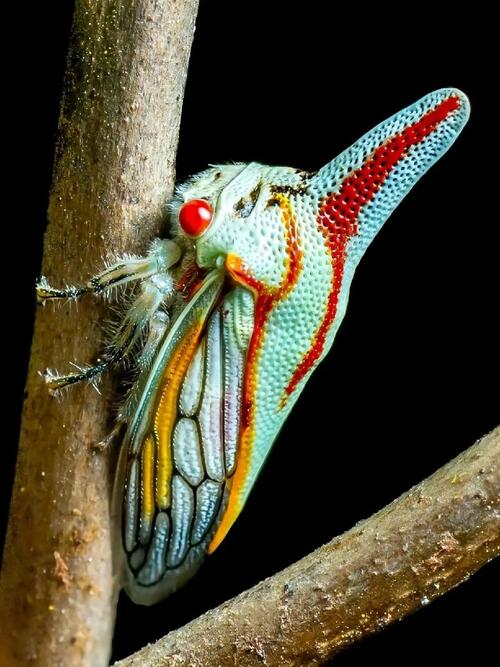
Is it toxic
Treehoppers are not poisonous themselves and do not directly harm humans or other animals through their bites, sucking, or secreting toxins. However, their behavior may indirectly have a negative impact on plants:
1. Non-toxic to humans:
Treehoppers do not have venom glands and do not release venom to humans or other animals like some poisonous insects (such as wasps or spiders), so they do not pose a direct threat to humans.
Treehoppers suck plant sap through piercing-sucking mouthparts. This behavior is harmless to humans and will not spread diseases or cause toxic reactions.
2. Effects on plants:
Treehoppers may have a pest effect on some crops and fruit trees. They suck plant sap to obtain nutrients, which may cause plant growth to slow, wilt, or even die, especially when treehoppers are in large numbers.
Although treehoppers themselves are not toxic, their sucking behavior can sometimes open the door to plant diseases, leading to bacterial or viral infections, which in turn cause plant diseases. This indirect pest effect is one of the reasons why treehoppers are considered harmful.
Summary
Treehoppers themselves are not toxic and are harmless to humans and most animals. However, in agriculture and horticulture, treehoppers may still be considered pests due to their potential to damage the health of plants. In natural ecosystems, they protect themselves through camouflage and other defense mechanisms, rather than through toxicity.












